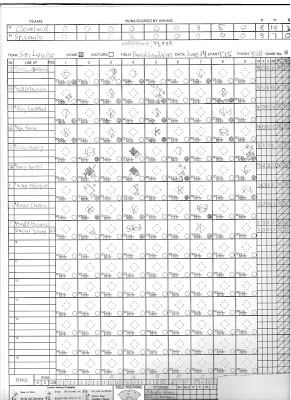The game here was more interesting than the final score of 8-3 would indicate; the Cardinals led 3-0 going into the seventh, but the Indians tied it that frame and won it with five in the eighth. It was also the first season of interleague play, and thanks to a Friday rainout, this was the first game of a doubleheader and the first ever meeting between the Tribe and Redbirds.
Saturday, April 26, 2008
#8---CLE @ STL, 6/14/1997
Saturday, April 19, 2008
#7---CLE @ BAL, 5/29/1997
Mike Mussina pitching.
Grissom struck out.
Franco grounded to short.
Thome struck out.
2ND INNING
Williams struck out.
Justice grounded to short.
Ramirez grounded to short.
3RD INNING
Fernandez struck out.
Alomar struck out.
Vizquel flied to left.
4TH INNING
Grissom grounded to pitcher.
Franco struck out.
Thome grounded to pitcher.
5TH INNING
Williams struck out.
Justice grounded to third.
Ramirez grounded to second.
6TH INNING
Fernandez popped to short.
Alomar struck out.
Vizquel struck out.
7TH INNING
Grissom flied to right.
Franco grounded to second.
Thome grounded to second.
8TH INNING
Williams grounded to first.
Justice flew to center.
Ramirez flew to right.
9TH INNING
Fernandez grounded to second.
Alomar singled (NOOOO!)
Giles hit for Vizquel; struck out.
Grissom struck out.
I still have not been fortunate enough to score a no-hitter, let alone a perfect game.
Saturday, April 12, 2008
#6---CLE @ OAK, 4/2/1997
So the sheet was very bare, and as I was scoring I had to mentally take note of where the borders of the scoreboxes should be. I do like some of what I was doing as far as actually scoring goes. Marking pitching changes with a symbol for the new pitcher in the box of the first batter was a lot better than writing his name at the bottom of the box. The boxes left enough room to comfortably record the basic details, and I was firmly entrenched in using the lineup position of the batter to record baserunner advancement. The 9-7
Saturday, April 5, 2008
#5---KC @ CLE, 9/20/1996
The scorekeeping was thoroughly unremarkable as well. It has the hallmarks of a sheet kept sloppily at a ballpark. Compared to my sheet from earlier in the season (#2), the quality of my scorekeeping had actually declined, although some of this had to be due to the ballpark setting.
The only improvement was utilizing the diamond by tracing the progress of runners. Unfortunately, this coincided with a lack of explaining how the runners progressed or even responsibility for RBI. Pitching changes were still clumsily indicated by writing the name at the bottom of the scorebox of the first batter faced, and the final score is nowhere to be found (also, in an unintentional error, the line score lists Cleveland with zero runs in the fifth when in fact they scored three. Jeff Kent’s means of reaching base in that inning is not recorded--it was a three-run longball).
One thing that made no sense to me when looking at this sheet was the scoring in the KC second. Randa singled, then has an “F” mark at second indicating he was retired on a fielder’s choice (16, hit into by Offerman). Offerman in turn was retired on Myers’ fielder’s choice. But what does “F6F” mean?
Looking at the Retrosheet scoring for the game, I have no idea what I was thinking at the time. First of all, Offerman’s FC was hit to first and was 36, not 16. The Myers play was a 46 FC--why that was “F6F” is a mystery to me. I hope it was just a mistake, intended to be “F46”, but who knows?
As has been the case with all of my sheets so far, I also made no mark to easily distinguish the end of the inning. I currently use a slash, but any of the techniques in use (some people draw two little hash marks at the bottom of the box, some people x out the first unused box, etc.) would make the sheet a lot easier to read.




